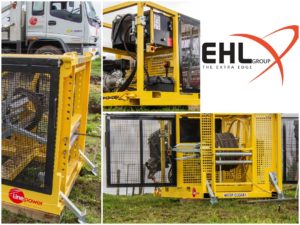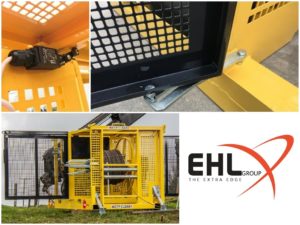LinePower Adaptable Cable Winders
Recently a client approached EHL’s Projects and Engineering team requiring a winder system that was versatile, robust, and portable. This unit needed to be able to be securely mounted on a tracked vehicle (in this case a Yanmar C30-R) for remote or off-road use, be transferable to a flatbed truck / utility, or offloaded for roadside or other use. The units needed to therefore be stand-alone with no reliance on an external power source, robust, balanced for ease of transferring between applications, and safe and easy to use for any of their crews.
EHL Group successfully designed, built, and deployed systems that encompasses the following features: Line pull up to 1,000kg depending on drum diameter utilising a 14hp petrol engine with electric start to drive a hydraulic motor. Proportional hydraulic speed control up to 35 RPM and Compliant to AS/NZS 4024 safety standards The Winder is intended to roll cable onto the the unique collapsible drum allowing for ease of winding on and removing from the winder. The drum has adjustable diameter and width as well as being removable to allow for different drum configurations to suit the application. The coiled cable is then secured to prevent uncoiling and then removed from the winder.
1. Collapsing Drum The cable is to be coiled onto the collapsing drum. The drum has anchoring points for the cable to be secured to when starting to coil the cable. It has a mechanism, that when released, reduces the diameter of the drum so the coil can easily be removed from the unit.  While the winder is coiling, the winder is to be securely anchored using the provided points to prevent any movement of the winder during coiling. The winder should not be used unless anchored securely.
While the winder is coiling, the winder is to be securely anchored using the provided points to prevent any movement of the winder during coiling. The winder should not be used unless anchored securely.
2. Anchoring Points 1. Lifting and Lashing Points The lifting and lashing points are for lifting the unit on and off transport and for lashing the unit down to a surface for transport. These points are not to be used for anchoring the unit while conducting winding operations 2. Rear Anchoring Points The rear anchor points are for securing the winder to a fixed structure to prevent the winder moving while conducting winding operations. The fixed structure can take a load of 3T safely.
3. Front Spades The front spades are used to stabilise the winder. They are angled at the ground and then driven into the ground with a hammer. For stowing, the spades are removed and replaced into the rotating receptacle vertically.  The winder can be attached to the Yanmar tracked vehicle carrier. While the winder is on the Yanmar, it can be transported to location and then used to coil cable in place.
The winder can be attached to the Yanmar tracked vehicle carrier. While the winder is on the Yanmar, it can be transported to location and then used to coil cable in place.
4. Hinged Guarding The winder has three hinged guards. These guards are to protect the operator and other persons from moving parts. These guards are to be securely closed using the latches provided when the winder is in use. The guards have interlock switches that prevent the winder from starting if the guards are open or shuts the winder down if the guards are opened during operation.

5. Cable Guide Rollers The cable is to run between two cable guide rollers. These rollers can be positioned into any of the vertical slots. Ensure that is the cable is to be wound over or under drum, both rollers are in an over or under position. Vertical guide pins can be placed in over and under positions to match the drum with. 1. Cable guide rollers 2. Vertical guide pins  Take a moment to view these short videos: Winding underway EHL Winding
Take a moment to view these short videos: Winding underway EHL Winding
The Process
The Result
The boys put the new Wire Winder through its paces yesterday. Worked like a dream and made the job heaps faster. It’s easily transported and can be attached to our Yanmar to get to those hard to get places.
Linepower Team - New Plymouth (NZ)
